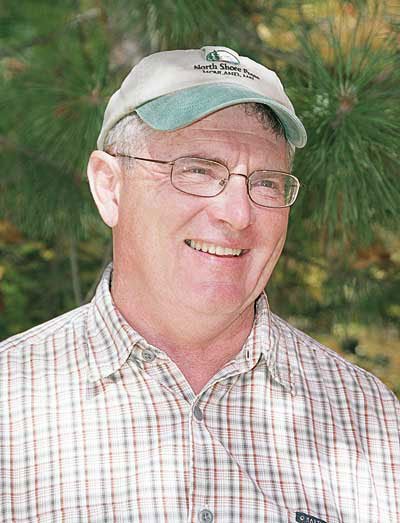The rumble of logging trucks is a sure sign of spring in my neighborhood. As the days grow longer, loggers are in a rush to get the timber harvested over the winter out of the woods before the county places spring weight limits on the roads. I watched the trucks drive by last Saturday while working on my wood pile; a personal rush to finish putting up next winter’s firewood before spring and its many distractions arrives.
In Minnesota, a logging truck may carry a 90,000-pound load of eight-foot logs. I purchase one of those truckloads about every other year. Using a chainsaw and a splitting maul, I turn the logs into chunks of firewood and then stack them in the woodshed. I’ve been doing this for a long time and so have learned how to use gravity and physics to minimize physical effort. I roll the logs down from the pile to cut them and use my foot to roll sawed lengths like heavy soccer balls away from my cutting area.
Even though my wood-processing system is fairly efficient, I still handle every piece of firewood for an average of five times from the time it is unloaded from the truck until it is tossed into the furnace. That means 90,000 pounds of wood delivered to me becomes 450,000 pounds that I move by hand. That’s 225 tons. When you toss in the time spent with the chain saw and splitting maul, processing firewood is quite the physical endeavor. Maybe I should produce an exercise video: The Firewood Workout Plan.
Another measure of the same truckload is that it, on average, represents a little less than an acre of forest harvest. If you think of that load of logs headed down the road as a creator of young forest habitat, it takes a lot of trucks to make a grouse copse or moose opening. In our northern forest, logging and fire and the only ways to get the new forest growth that is important to many game species, including moose and deer. From that perspective, I haven’t seen as many logging trucks as I once did.
Thoughts of habitat (you have plenty of time to think while cutting wood) led me to ponder the Minnesota DNR’s recent announcement that it is realigning antlerless permit areas in northeastern Minnesota to accommodate better deer and moose management. The agency intends to manage for more deer around the outer edge of the moose range and for fewer deer where the moose are. I happen to hunt in one of the permit areas which will be managed for fewer deer.
The agency hasn’t said what strategies they will use to manage for fewer deer. Quite likely, hunters will be encourage to kill does, perhaps with readily available antlerless permits or possibly bonus tags to encourage hunters to shoot an additional antlerless deer. Whether hunters will buy into such a strategy, which, in effect, is intended to diminish hunting opportunities, remains to be seen. What also remains to be seen is whether the state and tribes will continue the present moratorium on moose hunting. If not, DNR efforts to minimize deer numbers may be poorly received by hunters and the general public.
A significant number of hunters in traditional deer hunting locales such as the North Shore, Isabella and Ely will be affected by the new management scheme. It bears noting that deer hunting occurred in all of these locations back when the moose herd was thriving. “We used to have lots of moose and lots of deer,” is common observation among area hunters who have the perspective of a couple of decades or more.
When I first began deer hunting on the North Shore in the late 1980s, the abundance of whitetails was a surprise. In my previous hunting area south of the Iron Range, we worked hard for every deer we killed. On the Shore it was common then to see several deer during a day’s hunt. Nevertheless, only a few antlerless permits were issued by lottery.
Within a few years, I learned why. The 1991 Halloween Blizzard, which dumped up to three feet of snow along the North Shore, initiated a deer-killing winter. Just about the time the deer herd began to recover, along came the brutal 1995-96 winter, followed by the harsh 1996-97 winter. Once again, whitetail numbers plummeted.
It took just a few years for the population to bounce back. During the 2000s, there were seasons where North Shore hunters could kill up to five antlerless deer. This was also the time when the moose population began to noticeably decline. Deer remained abundant until the consecutive deep-snow winters of 2012-13 and 2013-14. Now the population is very low once again.
Aside from the winter-related ups and downs in the deer population, the biggest change that has occurred during the time I’ve lived on the North Shore has been the reduction in timber harvest. During the 80s and 90s, there were numerous, expansive clearcuts on national forest and state lands. Logging was considered a sturdy leg of the local economy. Today there are few loggers remaining and large clearcuts are uncommon. The lack of large forest openings on the landscape may mean less quality habitat is available for moose and deer.
Wildlife managers have traditionally told hunters that quality habitat is the primary factor in sustaining healthy game populations. On the North Shore, I’ve watched deer populations rise and fall in response to winter weather, despite wolf predation and, at times, liberal hunting bag limits. If there are fewer deer in the North Shore’s future, I wonder if this will reflect a successful management strategy or a decline in young forest habitat. If habitat is the deciding factor, then it is unlikely that fewer deer will mean more moose.
We suppress landscape-scale wildfires because of the risks they pose to human life and private property. In the absence of large fires, timber harvest is only way to alter and regenerate the boreal forest. But no one, especially wildlife managers, can wave a magic wand and create a demand for forest products. In the absence of that demand, fewer deer and fewer moose may be our future reality.




